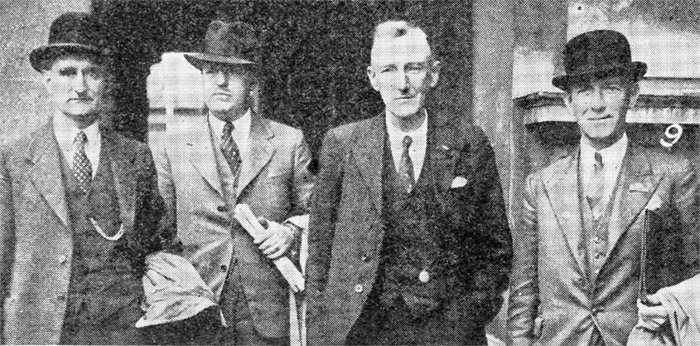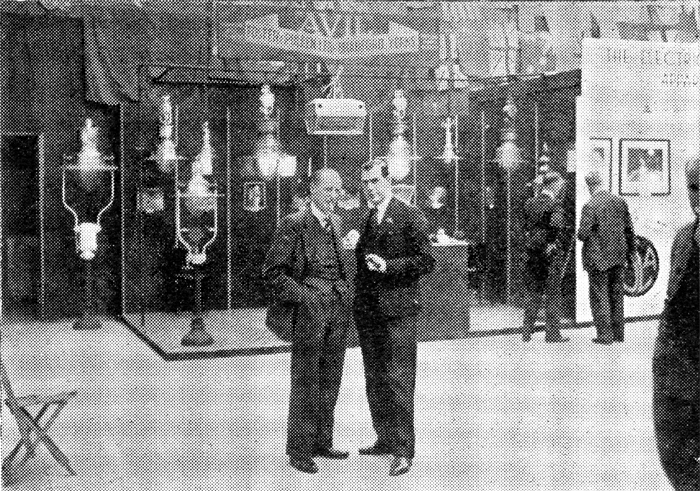|
esla

|
ESLA
The Electric Street Lighing Appartatus Co.
The Foundry
Kent
England
|
A. P. Trotter reads his paper on the "Distribution And Measurement Of Illumination" before the
Institution Of Civil Engineers in 1892. This is the first paper where street lighting is dealt with from a
scientific point of view and which was the basis on which measurements, contour curves and comparisons
were made. It inspired Haydn T. Harrison to specialise in this field. - [Public Lighting #36, 1945]
Harrison was an early advocate of higher efficiency, more even illumination and lower cost from
closer spacing and increasing the height of sources. He pushed these ideas in papers red before the
Institution Of Electrical Engineers (1910) and the Municipal Association (1925). He was gratified
that the Final Report (1937) also emphasised the same factors. - [Public Lighting #36, 1945]

A snapshot of four delegates taken at the APLE's 1936 conference at Cheltenham. The caption reads:
"Ald. Cullen, Mr. Harrison, Baillie Norris, Mr. R. M. Harvey." Is the man second from left
Lt.-Commander Haydn T. Harrison?
|
This lighting unit [the Bi-Multi] lends itself readily to the conversion of existing lanterns. For this purpose a slightly modified type is made;
this is fitted with four spring supports which are slipped into place in the lantern - The Illuminating Engineer, 1928.
Lt.-Commander Haydn T. Harrison is described as their Advising Engineer in 1932, having designed
the well-known Bi-Multi and Multi-plane fittings. Many thousands of the reflectors have been
installed throughout the country. Interestingly, it is also stated that the E.S.L.A. Company was the "first manufacturing
undertaking to devote itself exclusively to Street Lighting by Electricity" - this may mean that it was the first
street lighting manufacturing company to limit itself to electric lanterns. The 25 years actual practice puts the firms foundation
back to 1908; Harrison's loose title of Advising Engineer suggests that he provided a consultancy
role, which he also undertook at the GEC in the early 1920s. - APLE Exhibition Catalogue 1932
The company exhibited their Bi-Multi fittings at the 1936 APLE Conference in
Cheltenham including several of the latest type for mercury and sodium lamps. Other exhibits included
special lamp fittings, brackets etc. - Public Lighting #3, 1936

The firm's booth at the 1936 APLE Conference at Cheltenham (on the right).
 In 1937, the firm have produced a new horizontal ESLA Bi-Multi reflector for the 150-watt Philora
sodium lamp. The optical design "sectionalises" the long light source with the result that the excessively wide lateral light distribution is restricted
to more practical limits. Angular designs include those for acute bends and corners, as well as three and four-way types. A smaller version
is also being exhibited, this for 100W Philora lamps. New mercury versions of the Bi-Multi are being exhibited,
these being fitted with the 400W mercury lamp, and of the patented double tier design. - APLE Conference Programme 1937
In 1937, the firm have produced a new horizontal ESLA Bi-Multi reflector for the 150-watt Philora
sodium lamp. The optical design "sectionalises" the long light source with the result that the excessively wide lateral light distribution is restricted
to more practical limits. Angular designs include those for acute bends and corners, as well as three and four-way types. A smaller version
is also being exhibited, this for 100W Philora lamps. New mercury versions of the Bi-Multi are being exhibited,
these being fitted with the 400W mercury lamp, and of the patented double tier design. - APLE Conference Programme 1937
The firm stresses it adherence with the new MOT standards including the Bi-Multi
and Multiplane lanterns. New products are mentioned but not elaborated upon. - APLE Conference Programme 1938
An installation of the ESLA Group B/3HS Bi-Multi lantern, which is part of the exhibition, is
described. - APLE Conference Programme 1939
Resumption of the production of street lighting equipment starts in 1945 but the firm are relying
on their existing range and no new designs are on offer. - APLE Conference Programme 1945
By 1946, the firm are still actively pushing their Bi-Multi reflectors and are working
on new designs. Designs include the AL/1HS (for the 45W lamp),
AL/2HS (60W lamp) and AL/3HS (85-140W lamp). - APLE Conference Programme 1946
The firm apologise for not attending the Southport Conference in 1947. They are in production
of all types of their well-known Bi-Multi Reflector system of street lighting, both for home and export,
and are rapidly improving of delivery of units for Tungsten, Sodium and Mercury light shource. - APLE Conference Programme 1947
References:
The Illuminating Engineer 1928
APLE Exhibition Catalogue Blackpool 1932
APLE Conference Programme Folkestone 1937
APLE Conference Programme Bournemouth 1938
APLE Conference Programme Glasgow 1939
APLE Conference Programme Glasgow 1945
APLE Conference Programme London 1946
APLE Conference Programme Southport 1947
- External Links:
- Grace's Guide
|



